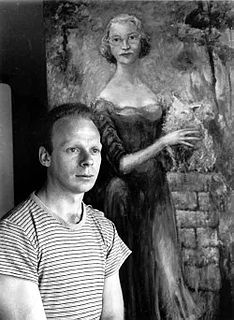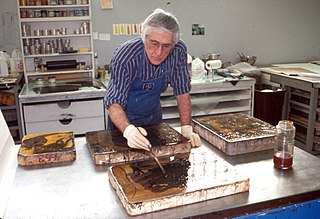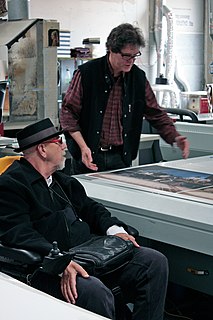Related Research Articles

Tapestry is a form of textile art, traditionally woven by hand on a loom. Tapestry is weft-faced weaving, in which all the warp threads are hidden in the completed work, unlike most woven textiles, where both the warp and the weft threads may be visible. In tapestry weaving, weft yarns are typically discontinuous; the artisan interlaces each coloured weft back and forth in its own small pattern area. It is a plain weft-faced weave having weft threads of different colours worked over portions of the warp to form the design.

Studio glass is the modern use of glass as an artistic medium to produce sculptures or three-dimensional artworks. The glass objects created are intended to make a sculptural or decorative statement. Though usage varies, the term is properly restricted to glass made as art in small workshops, typically with the personal involvement of the artist who designed the piece. This is in contrast to art glass, made by craftsmen in factories, and glass art, covering the whole range of glass with artistic interest made throughout history. Both art glass and studio glass originate in the 19th century, and the terms compare with studio pottery and art pottery, but in glass the term "studio glass" is mostly used for work made in the period beginning in the 1960s with a major revival in interest in artistic glassmaking.

The Massachusetts Museum of Contemporary Art is a museum in a converted Arnold Print Works factory building complex located in North Adams, Massachusetts. It is one of the largest centers for contemporary visual art and performing arts in the United States.
Mary Walker Phillips was an American textile artist, author and teacher. She revolutionized the craft of hand knitting by exploring knitting as an independent art form. In the catalog to her 1984 Fresno Arts Center exhibition, Jack Lenor Larsen described Phillips as the "transition between the old-fashioned, pattern-book knitting and the extraordinary things going on in England and America today." Her hand-knit tapestries and other creative pieces are exhibited in museums in the U.S. and Europe.

Peter de Witte, known in Italy as Pietro Candido and in Bavaria as Peter Candid was a Flemish-born Mannerist painter, tapestry designer and draughtsman active in Italy and Bavaria. He was an artist at the Medici court in Florence and at the Bavarian court of Duke William V and his successor Maximilian I in Munich.

June Claire Wayne was an American painter, printmaker, tapestry innovator, educator, and activist. She founded Tamarind Lithography Workshop (1960–1970), a then California-based nonprofit print shop dedicated to lithography.

Peter Benjamin Graham, was an Australian visual artist, printer, and art theorist.

Kenneth E. Tyler, AO is a master printmaker, publisher, arts educator and a prominent figure in the American post-war revival of fine art, limited edition printmaking. Tyler established leading print workshops and publishing houses on both West and East coasts of the United States and made several innovations in printmaking technology. His technical expertise and willingness to experiment on a bold scale drew many famous and influential artists to his workshops, among them Frank Stella, Helen Frankenthaler, Roy Lichtenstein, David Hockney, Robert Rauschenberg, Anthony Caro and Jasper Johns. Ken Tyler remains active as an educator and promoter of fine art printmaking, and mentor of a younger generation of printers through his various training and collecting institutions in Singapore, Japan, Australia and the US. The largest collection of prints produced at Tyler's successive workshops is currently held by the National Gallery of Australia.

Éva Farkas is a Hungarian tapestry artist.

The Moravská gobelínová manufaktura (MGM), is a tapestry manufactory in Valašské Meziříčí in the Zlín Region of the Czech Republic. The manufactory has been involved in the area of handmade classical and artistic tapestries, restoring and also creating new pieces with modern themes for more than fifty years. It is considered the first tapestry manufactory in Czechoslovakia, and the only workshop of this kind in Moravia and Czech Silesia.
Jane Kahan Gallery is an art gallery located in New York City that specializes in modern art. The gallery collection is founded on prints, monotypes, and paintings, including ceramics and works on paper by Pablo Picasso, and tapestries by artists such as Romare Bearden, Alexander Calder, Marc Chagall, Sonia Delaunay, Roberto Sebastián Matta, and Fernand Léger. Established by art dealer and collector Jane Kahan in 1973 following graduation from Mount Holyoke College, the gallery initially operated as Kahan Esikoff Fine Arts prior to changing the name to Jane Kahan Gallery. The gallery maintains its original space on the Upper East Side and an exhibition space in Lower Manhattan.

Brussels tapestry workshops produced tapestry from at least the 15th century, but the city's early production in the Late Gothic International style was eclipsed by the more prominent tapestry-weaving workshops based in Arras and Tournai. In 1477 Brussels, capital of the duchy of Brabant, was inherited by the house of Habsburg; and in the same year Arras, the prominent center of tapestry-weaving in the Low Countries, was sacked and its tapestry manufacture never recovered, and Tournai and Brussels seem to have increased in importance.
Aldeburgh Music is a registered charity delivering music performance, artist development and education, located in converted Victorian malting buildings on the edge of the River Alde in the village of Snape, Suffolk. Founded by Benjamin Britten, Peter Pears and Eric Crozier in 1947 as an organisation to present the first Aldeburgh Festival of Music and the Arts in 1948.

Dovecot Studios is a tapestry studio and arts venue in Edinburgh, Scotland.
Pedro Pablo Preux was a Mexican tapestry maker of French origin, part of an effort to revive the craft as an art form in Europe under Jean Luçart then introducing and promoting the concept in Mexico in the 1960s and 1970s. Although tapestry making as art declined back to handcraft status starting in the 1980s, Preux’s efforts were recognized with membership in the Salón de la Plástica Mexicana and the Sistema Nacional de Creadores de Arte.

Donald Sheridan Farnsworth is an American artist and inventor. He is currently the director of Magnolia Editions in Oakland, California.

Willem de Pannemaker, was a leading weaver of Brussels tapestry. He was the head of the Pannemaker tapestry workshop, was considered the greatest tapestry creator for his time, and is best known for his works for the Habsburgs.
Archie Brennan (1931-2019) was a noted Scottish tapestry weaver. He served his apprenticeship at the Edinburgh Tapestry Co and studied at Edinburgh College of Art. He went on to work at the College establishing their department of Tapestry and Fibre Arts. He also served Dovecot as their artistic director.

Marilyn Rea-Menzies is a New Zealand artist, principally known for her tapestry work, but who also exhibits drawing, painting, and digital print. She is considered one of New Zealand's leading textile artists.

Mary Zicafoose is an American textile artist, weaver, and teacher who specializes in ikat, an ancient technique in which threads are wrapped, tied and resist-dyed before weaving. Zicafoose is the author of Ikat: The Essential Handbook to Weaving Resist-Dyed Cloth (2020). Her works are part of private and public collections, including at least 16 embassies around the world as part of the U.S. Art in Embassies Program.
References
- ↑ Knezic, Sophie; Were, Ian; Cochius, Chris; Australian Tapestry Workshop (2010), Contemporary Australian tapestries, Australian Tapestry Workshop, ISBN 978-0-9803731-2-7
- ↑ Walker, Sue (2007). Artists' Tapestries. Sydney, Australia: The Beagle Press. ISBN 9780947349509.
- ↑ "Patross Knitting Mill". Australian Heritage Database. Department of the Environment. Retrieved 2014-09-15.